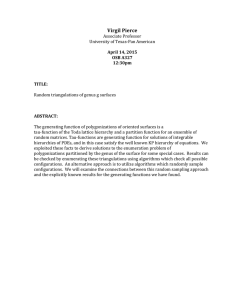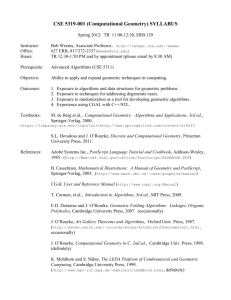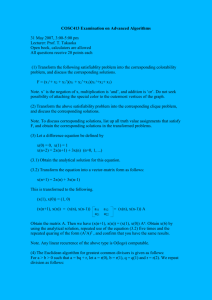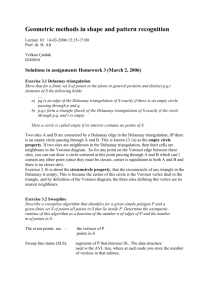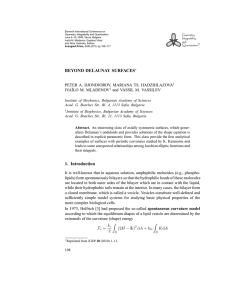Computational Geometry Delaunay Triangulations Lecture 12: Delaunay Triangulations Introduction
advertisement
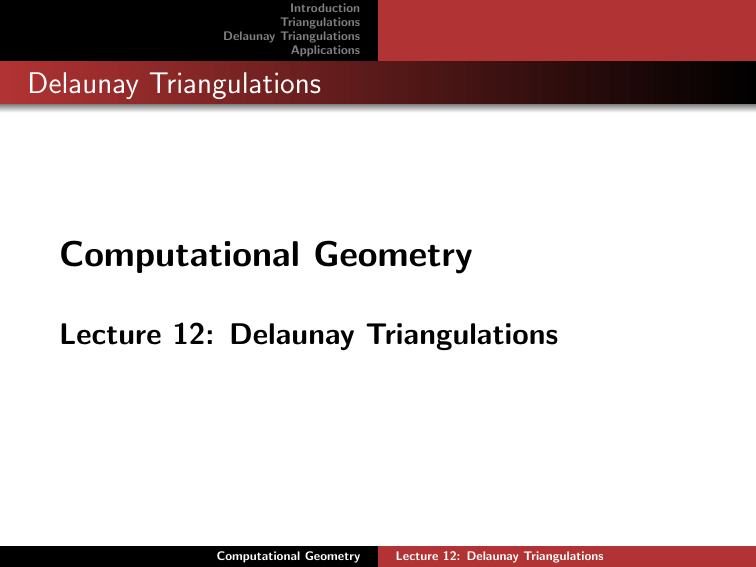
Introduction
Triangulations
Delaunay Triangulations
Applications
Delaunay Triangulations
Computational Geometry
Lecture 12: Delaunay Triangulations
Computational Geometry
Lecture 12: Delaunay Triangulations
Introduction
Triangulations
Delaunay Triangulations
Applications
Motivation: Terrains by interpolation
To build a model of the terrain
surface, we can start with a number
of sample points where we know the
height.
Computational Geometry
Lecture 12: Delaunay Triangulations
Introduction
Triangulations
Delaunay Triangulations
Applications
Motivation: Terrains
How do we interpolate the height at
other points?
211
Nearest neighbor interpolation
Piecewise linear interpolation by
a triangulation
Moving windows interpolation
Natural neighbor interpolation
233
?
235
258
240
...
Computational Geometry
246
Lecture 12: Delaunay Triangulations
251
Introduction
Triangulations
Delaunay Triangulations
Applications
Triangulation
Let P = {p1 , . . . , pn } be a point set.
A triangulation of P is a maximal
planar subdivision with vertex set P.
Complexity:
2n − 2 − k triangles
3n − 3 − k edges
where k is the number of points in P
on the convex hull of P
Computational Geometry
Lecture 12: Delaunay Triangulations
Introduction
Triangulations
Delaunay Triangulations
Applications
Triangulation
But which triangulation?
Computational Geometry
Lecture 12: Delaunay Triangulations
Introduction
Triangulations
Delaunay Triangulations
Applications
Triangulation
But which triangulation?
For interpolation, it is good if triangles are not long and
skinny. We will try to use large angles in our triangulation.
Computational Geometry
Lecture 12: Delaunay Triangulations
Introduction
Triangulations
Delaunay Triangulations
Applications
Angle Vector of a Triangulation
Let T be a triangulation of P with m triangles. Its angle
vector is A(T) = (α1 , . . . , α3m ) where α1 , . . . , α3m are the
angles of T sorted by increasing value.
Let T 0 be another triangulation of
P. We define A(T) > A(T 0 ) if A(T)
is lexicographically larger than
A(T 0 )
T is angle optimal if A(T) ≥ A(T 0 )
for all triangulations T 0 of P
Computational Geometry
α4
α5
α1
α6
α2
Lecture 12: Delaunay Triangulations
α3
Introduction
Triangulations
Delaunay Triangulations
Applications
Edge Flipping
pl
pl
α3
α5
α2
pi
α1
α4
pj
edge flip
α6
α20
pi
pk
α10
α40
α30
α60
α50
pk
Change in angle vector:
α1 , . . . , α6 are replaced by α10 , . . . , α60
The edge e = pi pj is illegal if min1≤i≤6 αi < min1≤i≤6 αi0
Flipping an illegal edge increases the angle vector
Computational Geometry
Lecture 12: Delaunay Triangulations
pj
Introduction
Triangulations
Delaunay Triangulations
Applications
Characterisation of Illegal Edges
How do we determine if an edge is illegal?
Lemma: The edge pi pj is illegal if
and only if pl lies in the interior of
the circle C.
pl
pj
pi
pk
Computational Geometry
Lecture 12: Delaunay Triangulations
illegal
Introduction
Triangulations
Delaunay Triangulations
Applications
Thales Theorem
Theorem: Let C be a circle, ` a line
intersecting C in points a and b, and
p, q, r, s points lying on the same side
of `. Suppose that p, q lie on C, r lies
inside C, and s lies outside C. Then
s
p
q
r
b
]arb > ]apb = ]aqb > ]asb,
where ]abc denotes the smaller
angle defined by three points a, b, c.
Computational Geometry
`
a
C
Lecture 12: Delaunay Triangulations
Introduction
Triangulations
Delaunay Triangulations
Applications
Legal Triangulations
A legal triangulation is a triangulation that does not contain
any illegal edge.
Algorithm LegalTriangulation(T)
Input. A triangulation T of a point set P.
Output. A legal triangulation of P.
1. while T contains an illegal edge pi pj
2.
do (∗ Flip pi pj ∗)
3.
Let pi pj pk and pi pj pl be the two triangles adjacent
to pi pj .
4.
Remove pi pj from T, and add pk pl instead.
5. return T
Question: Why does this algorithm terminate?
Computational Geometry
Lecture 12: Delaunay Triangulations
Introduction
Triangulations
Delaunay Triangulations
Applications
Properties
Voronoi Diagram and Delaunay Graph
Let P be a set of n points in the
plane
The Voronoi diagram Vor(P) is
the subdivision of the plane into
Voronoi cells V(p) for all p ∈ P
Let G be the dual graph of
Vor(P)
The Delaunay graph DG(P) is
the straight line embedding of G
Computational Geometry
Lecture 12: Delaunay Triangulations
Introduction
Triangulations
Delaunay Triangulations
Applications
Properties
Voronoi Diagram and Delaunay Graph
Let P be a set of n points in the
plane
The Voronoi diagram Vor(P) is
the subdivision of the plane into
Voronoi cells V(p) for all p ∈ P
Let G be the dual graph of
Vor(P)
The Delaunay graph DG(P) is
the straight line embedding of G
Computational Geometry
Lecture 12: Delaunay Triangulations
Introduction
Triangulations
Delaunay Triangulations
Applications
Properties
Voronoi Diagram and Delaunay Graph
Let P be a set of n points in the
plane
The Voronoi diagram Vor(P) is
the subdivision of the plane into
Voronoi cells V(p) for all p ∈ P
Let G be the dual graph of
Vor(P)
The Delaunay graph DG(P) is
the straight line embedding of G
Computational Geometry
Lecture 12: Delaunay Triangulations
Introduction
Triangulations
Delaunay Triangulations
Applications
Properties
Voronoi Diagram and Delaunay Graph
Let P be a set of n points in the
plane
The Voronoi diagram Vor(P) is
the subdivision of the plane into
Voronoi cells V(p) for all p ∈ P
Let G be the dual graph of
Vor(P)
The Delaunay graph DG(P) is
the straight line embedding of G
Computational Geometry
Lecture 12: Delaunay Triangulations
Introduction
Triangulations
Delaunay Triangulations
Applications
Properties
Planarity of the Delaunay Graph
Theorem: The Delaunay graph of a planar point set is a plane
graph.
contained in V(pi )
pi
Cij
pj
contained in V(pj )
Computational Geometry
Lecture 12: Delaunay Triangulations
Introduction
Triangulations
Delaunay Triangulations
Applications
Properties
Delaunay Triangulation
If the point set P is in general position then the Delaunay graph
is a triangulation.
f
Computational Geometry
v
Lecture 12: Delaunay Triangulations
Introduction
Triangulations
Delaunay Triangulations
Applications
Properties
Empty Circle Property
Theorem: Let P be a set of points in the plane, and let T be
a triangulation of P. Then T is a Delaunay triangulation of P
if and only if the circumcircle of any triangle of T does not
contain a point of P in its interior.
Computational Geometry
Lecture 12: Delaunay Triangulations
Introduction
Triangulations
Delaunay Triangulations
Applications
Properties
Delaunay Triangulations and Legal Triangulations
Theorem: Let P be a set of points in the plane. A triangulation
T of P is legal if and only if T is a Delaunay triangulation.
pm
C(pi pj pm )
pi
pl
e
pj
pk
C(pi pj pk )
Computational Geometry
Lecture 12: Delaunay Triangulations
Introduction
Triangulations
Delaunay Triangulations
Applications
Properties
Angle Optimality and Delaunay Triangulations
Theorem: Let P be a set of points in the plane.
Any angle-optimal triangulation of P is a Delaunay
triangulation of P. Furthermore, any Delaunay triangulation of
P maximizes the minimum angle over all triangulations of P.
Computational Geometry
Lecture 12: Delaunay Triangulations
Introduction
Triangulations
Delaunay Triangulations
Applications
Properties
Computing Delaunay Triangulations
There are several ways to compute the Delaunay triangulation:
By iterative flipping from any triangulation
By plane sweep
By randomized incremental construction
By conversion from the Voronoi diagram
The last three run in O(n log n) time [expected] for n points in
the plane
Computational Geometry
Lecture 12: Delaunay Triangulations
Introduction
Triangulations
Delaunay Triangulations
Applications
Minimum spanning trees
Traveling Salesperson
Shape Approximation
Using Delaunay Triangulations
Delaunay triangulations help in constructing various things:
Euclidean Minimum Spanning Trees
Approximations to the Euclidean
Traveling Salesperson Problem
α-Hulls
Computational Geometry
Lecture 12: Delaunay Triangulations
Introduction
Triangulations
Delaunay Triangulations
Applications
Minimum spanning trees
Traveling Salesperson
Shape Approximation
Euclidean Minimum Spanning Tree
For a set P of n points in the plane, the
Euclidean Minimum Spanning Tree is
the graph with minimum summed edge
length that connects all points in P and
has only the points of P as vertices
Computational Geometry
Lecture 12: Delaunay Triangulations
Introduction
Triangulations
Delaunay Triangulations
Applications
Minimum spanning trees
Traveling Salesperson
Shape Approximation
Euclidean Minimum Spanning Tree
For a set P of n points in the plane, the
Euclidean Minimum Spanning Tree is
the graph with minimum summed edge
length that connects all points in P and
has only the points of P as vertices
Computational Geometry
Lecture 12: Delaunay Triangulations
Introduction
Triangulations
Delaunay Triangulations
Applications
Minimum spanning trees
Traveling Salesperson
Shape Approximation
Euclidean Minimum Spanning Tree
Lemma: The Euclidean Minimum Spanning Tree does
not have cycles (it really is a tree)
Proof: Suppose G is the shortest connected graph and
it has a cycle. Removing one edge from the cycle makes
a new graph G0 that is still connected but which is
shorter. Contradiction
Computational Geometry
Lecture 12: Delaunay Triangulations
Introduction
Triangulations
Delaunay Triangulations
Applications
Minimum spanning trees
Traveling Salesperson
Shape Approximation
Euclidean Minimum Spanning Tree
Lemma: Every edge of the
Euclidean Minimum Spanning Tree
is an edge in the Delaunay graph
Proof: Suppose T is an EMST with
an edge e = pq that is not Delaunay
Consider the circle C that has e as
its diameter. Since e is not Delaunay,
C must contain another point r in P
(different from p and q)
Computational Geometry
p
r
q
Lecture 12: Delaunay Triangulations
Introduction
Triangulations
Delaunay Triangulations
Applications
Minimum spanning trees
Traveling Salesperson
Shape Approximation
Euclidean Minimum Spanning Tree
Lemma: Every edge of the
Euclidean Minimum Spanning Tree
is an edge in the Delaunay graph
p
r
Proof: (continued)
Either the path in T from r to p
passes through q, or vice versa.
The cases are symmetric, so we can
assume the former case
Computational Geometry
q
Lecture 12: Delaunay Triangulations
Introduction
Triangulations
Delaunay Triangulations
Applications
Minimum spanning trees
Traveling Salesperson
Shape Approximation
Euclidean Minimum Spanning Tree
Lemma: Every edge of the
Euclidean Minimum Spanning Tree
is an edge in the Delaunay graph
Proof: (continued)
p
Then removing e and inserting pr
instead will give a connected graph
again (in fact, a tree)
r
q
Since q was the furthest point from p
inside C, r is closer to q, so T was
not a minimum spanning tree.
Contradiction
Computational Geometry
Lecture 12: Delaunay Triangulations
Introduction
Triangulations
Delaunay Triangulations
Applications
Minimum spanning trees
Traveling Salesperson
Shape Approximation
Euclidean Minimum Spanning Tree
How can we compute a Euclidean Minimum Spanning Tree
efficiently?
From your Data Structures course: A data structure exists that
maintains disjoint sets and allows the following two operations:
Union: Takes two sets and makes one new set that is the
union (destroys the two given sets)
Find: Takes one element and returns the name of the set
that contains it
If there are n elements in total, then all Unions together take
O(n log n) time and each Find operation takes O(1) time
Computational Geometry
Lecture 12: Delaunay Triangulations
Introduction
Triangulations
Delaunay Triangulations
Applications
Minimum spanning trees
Traveling Salesperson
Shape Approximation
Euclidean Minimum Spanning Tree
Let P be a set of n points in the plane for which we want to
compute the EMST
1
Make a Union-Find structure where every point of P is in
a separate set
2
Construct the Delaunay triangulation DT of P
3
Take all edges of DT and sort them by length
For all edges e from short to long:
4
Let the endpoints of e be p and q
If Find(p) 6= Find(q), then put e in the EMST, and
Union(Find(p),Find(q))
Computational Geometry
Lecture 12: Delaunay Triangulations
Introduction
Triangulations
Delaunay Triangulations
Applications
Minimum spanning trees
Traveling Salesperson
Shape Approximation
Euclidean Minimum Spanning Tree
Step 1 takes linear time, the other three steps take O(n log n)
time
Theorem: Let P be a set of n points in the plane.
The Euclidean Minimum Spanning Tree of P can be
computed in O(n log n) time
Computational Geometry
Lecture 12: Delaunay Triangulations
Introduction
Triangulations
Delaunay Triangulations
Applications
Minimum spanning trees
Traveling Salesperson
Shape Approximation
The traveling salesperson problem
Given a set P of n points in the plane, the Euclidean Traveling
Salesperson Problem is to compute a tour (cycle) that visits
all points of P and has minimum length
A tour is an order on the points of P (more precisely: a cyclic
order). A set of n points has (n − 1)! different tours
Computational Geometry
Lecture 12: Delaunay Triangulations
Introduction
Triangulations
Delaunay Triangulations
Applications
Minimum spanning trees
Traveling Salesperson
Shape Approximation
The traveling salesperson problem
We can determine the length of each tour in O(n) time: a
brute-force algorithm to solve the Euclidean Traveling
Salesperson Problem (ETSP) takes O(n) · O((n − 1)!) = O(n!)
time
How bad is n!?
Computational Geometry
Lecture 12: Delaunay Triangulations
Introduction
Triangulations
Delaunay Triangulations
Applications
Minimum spanning trees
Traveling Salesperson
Shape Approximation
Efficiency
n
6
7
8
9
10
15
20
30
n2
36
49
64
81
100
225
400
900
2n
64
128
256
512
1024
32K
1M
1G
n!
720
5040
40K
360K
3.5M
2,000,000T
Clever algorithms can solve instances in O(n2 · 2n ) time
Computational Geometry
Lecture 12: Delaunay Triangulations
Introduction
Triangulations
Delaunay Triangulations
Applications
Minimum spanning trees
Traveling Salesperson
Shape Approximation
Approximation algorithms
If an algorithm A solves an optimization problem always
within a factor k of the optimum, then A is called an
k-approximation algorithm
If an instance I of ETSP has an optimal solution of length L,
then a k-approximation algorithm will find a tour of length
≤ k·L
Computational Geometry
Lecture 12: Delaunay Triangulations
Introduction
Triangulations
Delaunay Triangulations
Applications
Minimum spanning trees
Traveling Salesperson
Shape Approximation
Approximation algorithms
Consider the diameter problem of a set of n
points. We can compute the real value of
the diameter in O(n log n) time
Suppose we take any point p, determine its
furthest point q, and return their distance.
This takes only O(n) time
Question: Is this an approximation
algorithm?
Computational Geometry
Lecture 12: Delaunay Triangulations
Introduction
Triangulations
Delaunay Triangulations
Applications
Minimum spanning trees
Traveling Salesperson
Shape Approximation
Approximation algorithms
Consider the diameter problem of a set of n
points. We can compute the real value of
the diameter in O(n log n) time
Suppose we take any point p, determine its
furthest point q, and return their distance.
This takes only O(n) time
q
Question: Is this an approximation
algorithm?
Computational Geometry
p
Lecture 12: Delaunay Triangulations
Introduction
Triangulations
Delaunay Triangulations
Applications
Minimum spanning trees
Traveling Salesperson
Shape Approximation
Approximation algorithms
Suppose we determine the point with
minimum x-coordinate p and the point with
maximum x-coordinate q, and return their
distance. This takes only O(n) time
Question: Is this an approximation algorithm?
Computational Geometry
Lecture 12: Delaunay Triangulations
Introduction
Triangulations
Delaunay Triangulations
Applications
Minimum spanning trees
Traveling Salesperson
Shape Approximation
Approximation algorithms
Suppose we determine the point with
minimum x-coordinate p and the point with
maximum x-coordinate q, and return their
distance. This takes only O(n) time
Question: Is this an approximation algorithm?
Computational Geometry
Lecture 12: Delaunay Triangulations
Introduction
Triangulations
Delaunay Triangulations
Applications
Minimum spanning trees
Traveling Salesperson
Shape Approximation
Approximation algorithms
Suppose we determine the point with
minimum x-coordinate p and the point with
maximum x-coordinate q.
Then we determine the point with minimum
y-coordinate r and the point with maximum
y-coordinate s.
We return max(d(p, q), d(r, s)).
This takes only O(n) time
Question: Is this an approximation algorithm?
Computational Geometry
Lecture 12: Delaunay Triangulations
Introduction
Triangulations
Delaunay Triangulations
Applications
Minimum spanning trees
Traveling Salesperson
Shape Approximation
Approximation algorithms
Suppose we determine the point with
minimum x-coordinate p and the point with
maximum x-coordinate q.
Then we determine the point with minimum
y-coordinate r and the point with maximum
y-coordinate s.
We return max(d(p, q), d(r, s)).
This takes only O(n) time
Question: Is this an approximation algorithm?
Computational Geometry
Lecture 12: Delaunay Triangulations
Introduction
Triangulations
Delaunay Triangulations
Applications
Minimum spanning trees
Traveling Salesperson
Shape Approximation
Approximation algorithms
Back to Euclidean Traveling
Salesperson:
We will use the EMST to
approximate the ETSP
start at any vertex
Computational Geometry
Lecture 12: Delaunay Triangulations
Introduction
Triangulations
Delaunay Triangulations
Applications
Minimum spanning trees
Traveling Salesperson
Shape Approximation
Approximation algorithms
Back to Euclidean Traveling
Salesperson:
We will use the EMST to
approximate the ETSP
follow an edge on one side
Computational Geometry
Lecture 12: Delaunay Triangulations
Introduction
Triangulations
Delaunay Triangulations
Applications
Minimum spanning trees
Traveling Salesperson
Shape Approximation
Approximation algorithms
Back to Euclidean Traveling
Salesperson:
We will use the EMST to
approximate the ETSP
. . . to get to another vertex
Computational Geometry
Lecture 12: Delaunay Triangulations
Introduction
Triangulations
Delaunay Triangulations
Applications
Minimum spanning trees
Traveling Salesperson
Shape Approximation
Approximation algorithms
Back to Euclidean Traveling
Salesperson:
We will use the EMST to
approximate the ETSP
proceed this way
Computational Geometry
Lecture 12: Delaunay Triangulations
Introduction
Triangulations
Delaunay Triangulations
Applications
Minimum spanning trees
Traveling Salesperson
Shape Approximation
Approximation algorithms
Back to Euclidean Traveling
Salesperson:
We will use the EMST to
approximate the ETSP
proceed this way
Computational Geometry
Lecture 12: Delaunay Triangulations
Introduction
Triangulations
Delaunay Triangulations
Applications
Minimum spanning trees
Traveling Salesperson
Shape Approximation
Approximation algorithms
Back to Euclidean Traveling
Salesperson:
We will use the EMST to
approximate the ETSP
proceed this way
Computational Geometry
Lecture 12: Delaunay Triangulations
Introduction
Triangulations
Delaunay Triangulations
Applications
Minimum spanning trees
Traveling Salesperson
Shape Approximation
Approximation algorithms
Back to Euclidean Traveling
Salesperson:
We will use the EMST to
approximate the ETSP
skipping visited vertices
Computational Geometry
Lecture 12: Delaunay Triangulations
Introduction
Triangulations
Delaunay Triangulations
Applications
Minimum spanning trees
Traveling Salesperson
Shape Approximation
Approximation algorithms
Back to Euclidean Traveling
Salesperson:
We will use the EMST to
approximate the ETSP
skipping visited vertices
Computational Geometry
Lecture 12: Delaunay Triangulations
Introduction
Triangulations
Delaunay Triangulations
Applications
Minimum spanning trees
Traveling Salesperson
Shape Approximation
Approximation algorithms
Back to Euclidean Traveling
Salesperson:
We will use the EMST to
approximate the ETSP
skipping visited vertices
Computational Geometry
Lecture 12: Delaunay Triangulations
Introduction
Triangulations
Delaunay Triangulations
Applications
Minimum spanning trees
Traveling Salesperson
Shape Approximation
Approximation algorithms
Back to Euclidean Traveling
Salesperson:
We will use the EMST to
approximate the ETSP
skipping visited vertices
Computational Geometry
Lecture 12: Delaunay Triangulations
Introduction
Triangulations
Delaunay Triangulations
Applications
Minimum spanning trees
Traveling Salesperson
Shape Approximation
Approximation algorithms
Back to Euclidean Traveling
Salesperson:
We will use the EMST to
approximate the ETSP
skipping visited vertices
Computational Geometry
Lecture 12: Delaunay Triangulations
Introduction
Triangulations
Delaunay Triangulations
Applications
Minimum spanning trees
Traveling Salesperson
Shape Approximation
Approximation algorithms
Back to Euclidean Traveling
Salesperson:
We will use the EMST to
approximate the ETSP
skipping visited vertices
Computational Geometry
Lecture 12: Delaunay Triangulations
Introduction
Triangulations
Delaunay Triangulations
Applications
Minimum spanning trees
Traveling Salesperson
Shape Approximation
Approximation algorithms
Back to Euclidean Traveling
Salesperson:
We will use the EMST to
approximate the ETSP
skipping visited vertices
Computational Geometry
Lecture 12: Delaunay Triangulations
Introduction
Triangulations
Delaunay Triangulations
Applications
Minimum spanning trees
Traveling Salesperson
Shape Approximation
Approximation algorithms
Back to Euclidean Traveling
Salesperson:
We will use the EMST to
approximate the ETSP
skipping visited vertices
Computational Geometry
Lecture 12: Delaunay Triangulations
Introduction
Triangulations
Delaunay Triangulations
Applications
Minimum spanning trees
Traveling Salesperson
Shape Approximation
Approximation algorithms
Back to Euclidean Traveling
Salesperson:
We will use the EMST to
approximate the ETSP
and close the tour
Computational Geometry
Lecture 12: Delaunay Triangulations
Introduction
Triangulations
Delaunay Triangulations
Applications
Minimum spanning trees
Traveling Salesperson
Shape Approximation
Approximation algorithms
Back to Euclidean Traveling
Salesperson:
We will use the EMST to
approximate the ETSP
and close the tour
Computational Geometry
Lecture 12: Delaunay Triangulations
Introduction
Triangulations
Delaunay Triangulations
Applications
Minimum spanning trees
Traveling Salesperson
Shape Approximation
Approximation algorithms
Why is this tour an approximation?
The walk visits every edge twice,
so it has length 2 · |EMST|
The tour skips vertices, which
means the tour has length
≤ 2 · |EMST|
The optimal ETSP-tour is a
spanning tree if you remove any
edge!!!
So |EMST| < |ETSP|
Computational Geometry
optimal ETSP-tour
Lecture 12: Delaunay Triangulations
Introduction
Triangulations
Delaunay Triangulations
Applications
Minimum spanning trees
Traveling Salesperson
Shape Approximation
Approximation algorithms
Theorem: Given a set of n points in the plane, a tour visiting
all points whose length is at most twice the minimum possible
can be computed in O(n log n) time
In other words: an O(n log n) time, 2-approximation for ETSP
exists
Computational Geometry
Lecture 12: Delaunay Triangulations
Introduction
Triangulations
Delaunay Triangulations
Applications
Minimum spanning trees
Traveling Salesperson
Shape Approximation
α-Shapes
Suppose that you have a set of
points in the plane that were
sampled from a shape
We would like to reconstruct the
shape
Computational Geometry
Lecture 12: Delaunay Triangulations
Introduction
Triangulations
Delaunay Triangulations
Applications
Minimum spanning trees
Traveling Salesperson
Shape Approximation
α-Shapes
Suppose that you have a set of
points in the plane that were
sampled from a shape
We would like to reconstruct the
shape
Computational Geometry
Lecture 12: Delaunay Triangulations
Introduction
Triangulations
Delaunay Triangulations
Applications
Minimum spanning trees
Traveling Salesperson
Shape Approximation
α-Shapes
An α-disk is a disk of radius α
The α-shape of a point set P is the
graph with the points of P as the
vertices, and two vertices p, q are
connected by an edge if there exists
an α-disk with p and q on the
boundary but no other points if P
inside or on the boundary
Computational Geometry
Lecture 12: Delaunay Triangulations
Introduction
Triangulations
Delaunay Triangulations
Applications
Minimum spanning trees
Traveling Salesperson
Shape Approximation
α-Shapes
An α-disk is a disk of radius α
The α-shape of a point set P is the
graph with the points of P as the
vertices, and two vertices p, q are
connected by an edge if there exists
an α-disk with p and q on the
boundary but no other points if P
inside or on the boundary
Computational Geometry
Lecture 12: Delaunay Triangulations
Introduction
Triangulations
Delaunay Triangulations
Applications
Minimum spanning trees
Traveling Salesperson
Shape Approximation
α-Shapes
An α-disk is a disk of radius α
The α-shape of a point set P is the
graph with the points of P as the
vertices, and two vertices p, q are
connected by an edge if there exists
an α-disk with p and q on the
boundary but no other points if P
inside or on the boundary
Computational Geometry
Lecture 12: Delaunay Triangulations
Introduction
Triangulations
Delaunay Triangulations
Applications
Minimum spanning trees
Traveling Salesperson
Shape Approximation
α-Shapes
An α-disk is a disk of radius α
The α-shape of a point set P is the
graph with the points of P as the
vertices, and two vertices p, q are
connected by an edge if there exists
an α-disk with p and q on the
boundary but no other points if P
inside or on the boundary
Computational Geometry
Lecture 12: Delaunay Triangulations
Introduction
Triangulations
Delaunay Triangulations
Applications
Minimum spanning trees
Traveling Salesperson
Shape Approximation
α-Shapes
Because of the empty disk property
of Delaunay triangulations (each
Delaunay edge has an empty disk
through its endpoints), every
α-shape edge is also a Delaunay
edge
Hence: there are O(n) α-shape
edges, and they cannot properly
intersect
Computational Geometry
Lecture 12: Delaunay Triangulations
Introduction
Triangulations
Delaunay Triangulations
Applications
Minimum spanning trees
Traveling Salesperson
Shape Approximation
α-Shapes
Given the Delaunay triangulation, we
can determine for any edge all sizes
of empty disks through the endpoints
in O(1) time
So the α-shape can be computed in
O(n log n) time
Computational Geometry
Lecture 12: Delaunay Triangulations
Introduction
Triangulations
Delaunay Triangulations
Applications
Minimum spanning trees
Traveling Salesperson
Shape Approximation
Conclusions
The Delaunay triangulation is a versatile structure that can be
computed in O(n log n) time for a set of n points in the plane
Approximation algorithms are like heuristics, but they come
with a guarantee on the quality of the approximation. They
are useful when an optimal solution is too time-consuming to
compute
Computational Geometry
Lecture 12: Delaunay Triangulations
